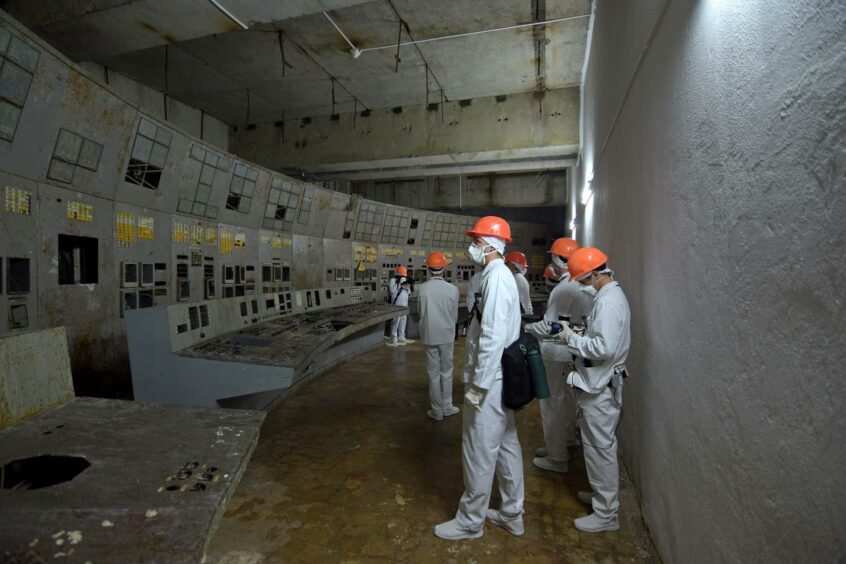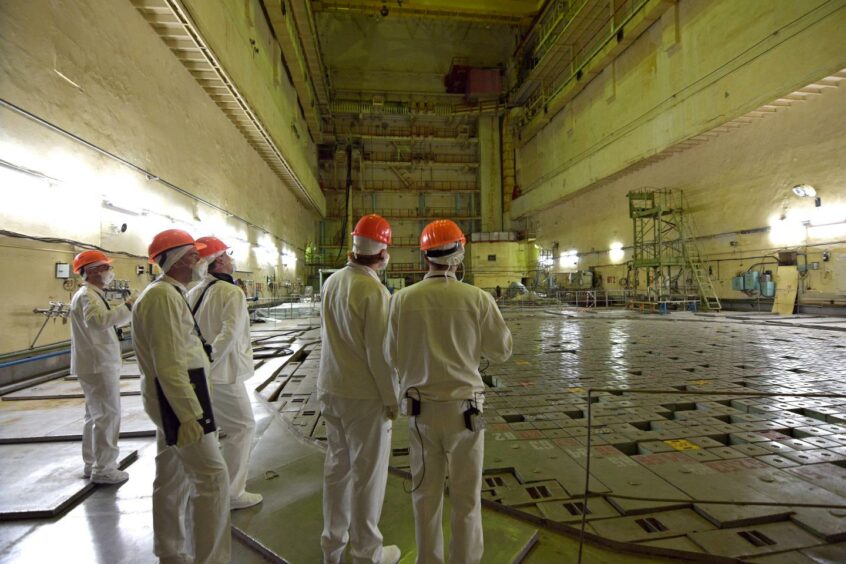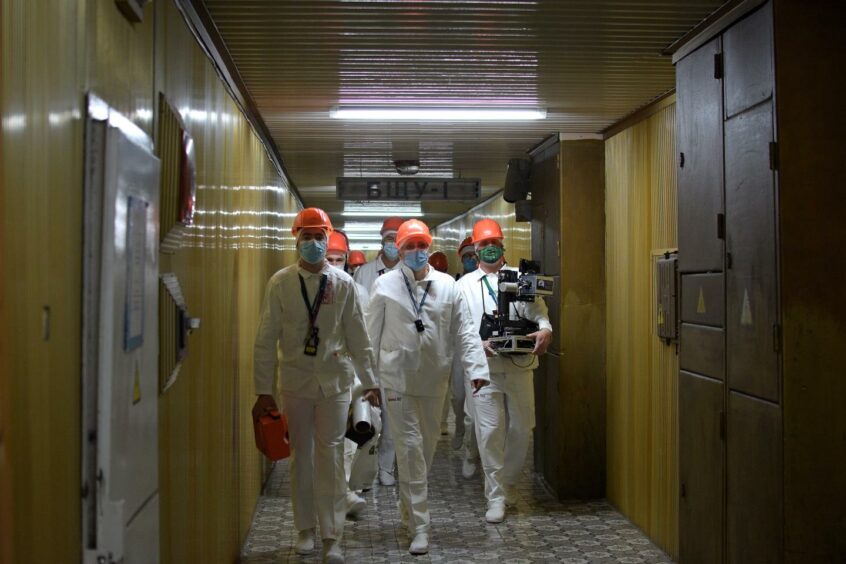
A team of scientists from Bristol University have been given unprecedented access to the infamous Chernobyl Nuclear Power Plant.
Alongside Ukrainian counterparts, researchers deployed specially developed radiation mapping and scanning sensors in the control room of Reactor 4, the epicentre of the world changing disaster in 1986.
They were also installed inside the New Safe Confinement (NSC) – the protective structure erected to cover the remains of the failed reactor – and the original Sarcophagus, which was hastily constructed in the aftermath of the accident.
Funded by the Robotics and AI in Nuclear (RAIN) research consortium, it was the team’s fourth visit to Chernobyl.
It follows the signing of a Memorandum of Understanding early this year between Bristol University, the Institute for Safety Problems of Nuclear Power Plants (ISPNPP) and the Ukraine National Academy of Science.
The aim of this visit was to further explore the value of autonomous and semi-autonomous radiation mapping systems in high-radiation environments.
By deploying these systems in the exclusion zone and at the power plant, researchers were able to better define the location and amount of residual radiological hazards.
On this occasion, researchers demonstrated several robotic systems, fitted with ground-breaking sensing equipment developed between the universities of Bristol and Oxford, as part of the RAIN project.
The aim of each system was to collect highly accurate 3D models of the facility, coincident with radiation data, to accurately define the distribution and severity of the radiological risks.
The ultimate goal of the initiative is to develop new technology for decreasing risk associated with decommissioning nuclear facilities.
Lead researcher, Professor Tom Scott, from Bristol University and co-director of RAIN, said: “To actually venture inside the control room of the failed reactor was a tense and yet exhilarating experience. The team did a fantastic job of deploying our systems quickly and in challenging conditions. It’s a huge reward after months of hard work and planning to know our technology performs well in real nuclear environments.
“This high-profile deployment was the culmination of several years of hard development work as part of the RAIN project. We’re so pleased to have successfully demonstrated a capability that is both useful for Chernobyl decommissioning but also for legacy nuclear sites in the UK and elsewhere in the world.
“We are now entering a phase of decommissioning here in the UK, at Sellafield and Magnox, therefore we are developing new sensing systems, robotic solutions and special types of detectors because that technology is needed now.
“Robots can make nuclear decommissioning faster, cheaper and more importantly, safer! We would only be able to develop this technology with the guidance and information from our Ukrainian partners.”
On April 26 1986, the worst nuclear accident in history played out at the power plant in the north of what is now called Ukraine, but what was then part of the USSR.
A series of explosions exposed Reactor 4 at the facility near Chernobyl, causing enormous amounts of radiation to spill out into the atmosphere.
At first, it was kept under wraps by the Soviet Government, but as the effects began to spread across Europe, the scale of the disaster was revealed.
At least 28 people were killed as a result of the blast, while thousands more suffered the degenerative impacts of radiation poisoning.
An exclusion zone is in place around the abandoned city and the impacts of the disaster can still be found in the nearby environment.
Public interest in the disaster was renewed by the 2019 HBO miniseries Chernobyl, which scooped numerous awards.
In the twelve months since their last visit to the site, the Bristol University team has made significant technological advances.
This time they used cutting-edge radiation sensing and laser mapping solution to address the challenging environment inside the shelter.
Dave Megson-Smith, senior research associate at Bristol’s Interface Analysis Centre (IAC), said: “With this type of multi-sensor system we can help our Ukrainian colleagues in conducting a diverse set of advanced characterisation and survey tasks in the most challenging of environments.”
Peter Martin, also from the IAC and a Royal Academy of Engineering research fellow, said: “Entering the Chernobyl Nuclear Power Plant is far from trivial and in order to practice for the deployments we were allowed to deploy the sensing technologies in Reactor Unit 3 and the control room of Unit 4, before venturing inside the New Safe Confinement. We were very pleased that the systems performed exactly as expected, recording excellent data that we can quickly construct 3D digital representations from.”
Now back in the UK, the pioneering research team will further analyse the data collected at the site and provide the Ukrainian authorities with previously unavailable, highly detailed, and accurate maps of the distribution of radiation levels surrounding the condemned reactor.
Leonid Yakovenko, head of the Chernobyl Nuclear Power Plant Radiation Safety Shop, said: “The success of this important research owes itself to the effective collaboration between the scientists of ISPNPP, the University of Bristol, and the specialist engineers from the Chernobyl Nuclear Power Plant. Together we have been able to carry out novel experiments using pioneering technology to assess the radiation situation at the Chernobyl NPP and, particularly, inside the new safe confinement zone.
“The Bristol team demonstrated the effectiveness of their scanning systems in high radiation conditions, producing detailed data within the facility and paving the way for more advanced remote robotic radiation mapping.”
Maxim Saveliev, senior researcher at the Institute for Safety Problems of Nuclear Power Plants (ISPNPP) in Ukraine, said: “Importantly, this scientific data will inform future planning for the eventual removal of fuel-containing material from the Shelter facility and will ultimately aid Chernobyl’s transformation – and the area surrounding it – into an environmentally safe place.
“This is the second time we have worked with the Bristol team here at the Chernobyl nuclear power plant and the results of this most recent visit provide fresh impetus for continuing and strengthening our cooperation into the future.”

 © Supplied by SSE Chornobyl NPP
© Supplied by SSE Chornobyl NPP © Supplied by SSE Chornobyl NPP
© Supplied by SSE Chornobyl NPP